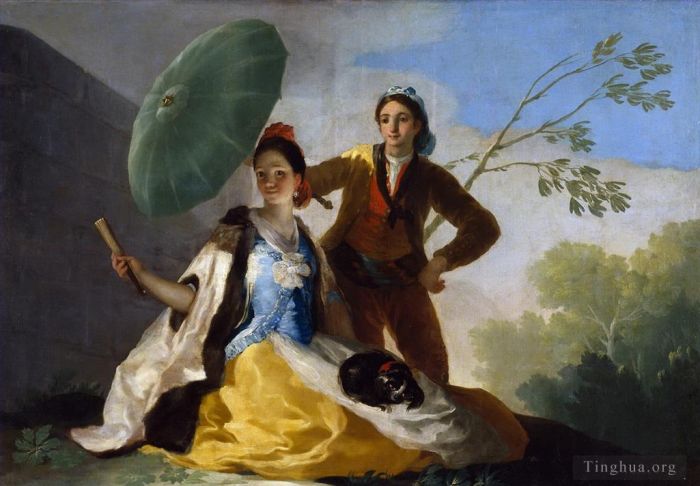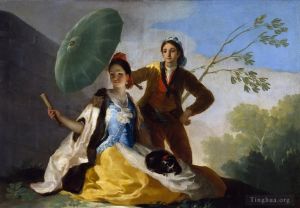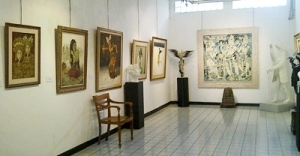The Parasol
Francisco Goya
- Price: Price on Request
- Art Type: Oil Painting
- Size:
- English Comments: 0
- International Comments: 0
- Creating Date:
- Introduction and Works of Francisco Goya >>
Keywords:
Parasol
Work Overview
- The Parasol
Spanish: El Quitasol
Artist Goya
Year c. 1777
Type Oil on linen
Dimensions 104 cm × 152 cm (40 3⁄4 in × 59 1⁄4 in)
Style Romanticism
Genre genre painting
Location Museo del Prado, Madrid
The Parasol (also known as El Quitasol) is one of a cartoon series of oil on linen paintings made by the painter Francisco Goya. This series of paintings was specifically made in order to be transformed into tapestries that would be hung on the walls of the Royal Palace of El Pardo in Madrid, Spain. The tapestries showed serene events in everyday life, which made them a nice addition to the dining room of Prince and Princess of Asturias—the future King Charles IV and Maria Luisa of Parma. The queen called on Goya because she wanted to decorate the dining room with cheerful scenes; The Parasol and the other tapestry paintings were Goya's response to this request. The painting is currently located in the Museo del Prado in Madrid as is another in the series, Blind man's bluff.
On July 25, 1773, Goya married Josefa, the sister of Francisco Bayeu. Bayeu was a member of the Royal Academy of Fine Art and helped Goya to secure his place with the Royal Tapestry Workshop. He designed 42 patterns in five years that would soon insulate and decorate the walls of the Palacio Real de El Pardo. This series of tapestries demonstrated Goya's talent enough to give him access to the Royal Court, and drastically change his career. Goya went on to expand his patrons and paint for many royal court members, such as the Count of Floridablanca, of whom he painted a portrait under commission. This all led up to the peak of Goya's career, during the reign of Charles IV, right after the French revolution.
In his paintings, Goya often joins French fashion to the Spanish one. The woman in this particular painting is sitting on the ground, possibly resting from a long walk. She is dressed in French style, according to the time period. She is holding a fan in her right hand, while a little dog is cuddled in her lap. The young man is holding the parasol (umbrella) in order to shade the woman's face. He is dressed in the so-called majo style, meaning he is dressed like a poor person for the time period. His hair gathered in a net, and his belt is made of colorful silk. In the background we can see dark clouds in the sky and the trees swaying in the wind, possibly signaling a storm coming. The painting has very calm warmth it emits, which is then offset by the tree that seems to be blowing in pretty strong wind. The way the boy is standing, with one foot on the rock and one not, he seems to be triumphantly shading the woman from the harmful rays of the sun, and the possible storm.
From 1775 to 1792 Goya painted his cartoons (designs) for the tapestries. This was his first genre of paintings and possibly the most important period in his artistic development. Painting the tapestries helped Goya become a keen observer of human behavior, which helped him paint his future paintings. Goya was influenced by neoclassicism, which was gaining favor over the rococo style at the time. This particular painting is considered classicism for its relation to everyday life. Around this same time, Goya began painting portraits for many of the Spanish Monarchs. This was his first popular success that ultimately changed his career. He was then elected to the Royal Academy of San Fernando in 1780, named painter to the king in 1786, and made a court painter in 1789.
This tapestry cartoon depicts a young woman. She is sitting, with a dog on her lap, and is accompanied by a Majo who protects her from the sun with a parasol. This work's format and bottom-to-top perspective indicates that it was intended to hang over a window. It's pyramidal composition, with the figures in the foreground, reflects the influence of classical Italian painting on Goya, as well as his mastery at painting light and shadows. The resultant tapestry was intended to hang in the dining room of the Prince and Princess of Asturias (the future Carlos IV and his wife Maria Luisa de Parma) at the Monastery of El Escorial. This work was part of a decorative series of ten cartoons for tapestries on “countryside” subjects. Goya, himself, invented the specific composition of the present one. This work entered the Prado Museum Collection in 1870 by way of Madrid's Royal Palace.
--------------------------------
Francisco Jose de Goya y Lucientes of Spain was a very famous painter and printmaker of the eighteenth century. His immense popularity is attributed to his European style of painting, fetching the appreciation of the European kings and queens. Goya's "The Parasol" or "the Quitasol," painted in 1777, is by far his most successful painting. Most of his paintings were centered on women, including this one. Goya created "The Parasol" when the Prince and the Princess of Asturias called him to Madrid to paint cartoons for their dining room tapestry in the Royal Palace of El Pardo in Madrid. A copy of "The Parasol" was woven into wool for hanging in the palace.
This oil on linen painting, measuring 104 cm x 152 cm, is known for its brilliant color scheme and brightness. "The Parasol" or "The Quitasol" depicts a pretty, young woman sitting on a hillock with a folded fan in her right hand. Dressed in the then French style, she is wearing a bright yellow skirt with a blue blouse lined with fur, and a dark brown shawl. A red scarf adorns her head. On her lap, rests a little black and white puppy. Next to her, stands a young man dressed in Majo or Maja style. He is wearing a brown coat with a light red waistcoat. He holds a bright green 'parasol' (umbrella) right above the woman's countenance. The left arm of the man is folded to rest on his waist. The folded fan, the 'parasol,' and the puppy suggest that the woman follows French fashion and belongs to a royal family, which creates an air of vanity about her. In the background, the leafy branches of a tall tree, bending opposite to the two human figures, depict windy weather. Towards the right side of the damsel is a high stonewall. Therefore, Goya has purposely placed all the bright colors, such as green, blue, red, and yellow in the center of the picture to create a cheerful effect, which was exactly compliant to the desires of the royal family. The flirtatious smile of the protagonist along with her direct gaze adds to the vivaciousness of the painting and gives a classic touch to it.
Francisco's pictures were always appreciated for their light and shadow effect. His creation of light on canvas was magnificent and this helped him capture a warm and cozy environment in his paintings. In "The Parasol" or "The Quitasol," too he has used lead white paint to create brightness and shadow lines. The elegance and the beauty of this painting, dipped in 'Classicism,' always had people flocking to admire it at the Prado Museum (Museo del Prado) in Madrid, where it is currently displayed.
- Copyright Statement:
All the reproduction of any forms about this work unauthorized by Singing Palette including images, texts and so on will be deemed to be violating the Copyright Laws.
To cite this webpage, please link back here.
- >> English Comments
- >> Chinese Comments
- >> French Comments
- >> German Comments
- >>Report
- Still life with fruit bottles breads
- The Meadow of San Isidro on his Feast Day
- The Swing
- Portrait of the Marchioness of Santa Cruz
- The Architect Don Tiburcio Perezy Cuervo
- The White Duchess
- The Duke of Wellington
- Knife Grinder
- Bullfight in a Divided Ring
- The Fair at Madrid
- Queen Maria Luisa Wearing a Mantilla
- King Carlos IV in Hunting Costume
- The Wedding
- The Maja and the Masked Men
- Don Ramon Satue
- The Fire
- The Countess of El Carpio
- The Parasol
- Don Manuel Osorio Manrique de Zuniga
- Fernando VII
- Fight With Cudgels
- The Marquesa de Pontejos
- Powder Factory in the Sierra
- The Straw Manikin
- The Black Duchess or Mourning Portrait of the Duchess of Alba
- Portrait of Mariano Goya
- Saturn Devouring His Son
- Juan Antonio Llorente
- Still life of Sheep Ribs and Head The Butcher conter
- Virgin Mary as Queen of Martyrs
- Mariana Waldstein
- Portrait of Maria Teresa de Vallabriga on horseback
- Majas on a Balcony
- Portrait of Victor Guye
- Portrait of the Countess of Chincon
- Bartholomew Suerda
- A Walk in Andalusia
- The military and senora
- Two Monks
- Winter The Snowstorm
- The Second of May 1808 (The Charge of the Mamelukes)
- Asensio Julia
- The Burial of the Sardine (Corpus Christi Festival on Ash Wednesday)
- Christ on the Mount of Olives
- Highwaymen Attacking a Coach (Robbery of the coach)
- Young Majas
- The picnic
- Charles III
- Sebastian Martinez
- Maja and Celestina on a Balcony
- The school scene
- The Pilgrimage of San Isidro
- Procession of Flagellants
- The Burial of Christ
- Portrait of the Countess of Carpio
- Marquesa de Pontejos
- The Family of the Infante Don Luis
- The Blind Guitar Player
- Don Juan Antonio Cuervo
- The Great He-Goat Or Witches Sabbath
- Portrait of Francisco Bayeu
- Time of the Old Women
- Nude Maja
- Bullfight
- The Repentant Saint Peter
- Truth Rescued by Time
- The Marquesa de la Solana
- Charles IV of Spain and His Family
- Infante Don Sebastian Gabriel de Borbon y Braganza
- Village Procession
- The Arrest of Christ
- Dona Tadea Arias de Enriquez
- Robbery
- Self portrait 2
- Still life plucked turkey and pan with fish
- Clothed Maja
- The Sacrifice to Vesta
- Blind Man Playing the Guitar
- The Quail Shoot
- Summer or The Harvest
- Self Portrait2
- Ferdinand Guillemardet
- The Duke of Osuna and his Family
- The Strolling Players
- Portrait of Senora Berm sezne Kepmesa
- El Lazarillo de Tormes
- St Francis Borgia Helping a Dying Impenitent
- Sketch for The Death of Saint Joseph
- Duchess Countess of Benavente
- Duke of Alba
- The Crockery Vendor
- Village Bullfight
- Portrait thought to be Josepha Bayeu
- Portrait of Jose Antonio
- The Third of May 1808 (The Executions)
- Still Life with Sheeps Head
- The Second of May 1808
- Self portrait 1
- Pedro Romero
- Count Fernand Nunez VII
- The Colossus
- Duke of Alba 2
- Dona Isabel Cobos de Porcel
- Self portrait in the Studio
- Dismemberment of the corpse of Jesuit Brefeb
- Plague Hospital
- The Holy Family
- The Last Communion of St Joseph Calasanz
- Portrait of charle iv of spain
- Boys playing soldiers
- The Snowstorm
- Self Portrait
- Water Carrier
- Vagabonds Resting in a Cave
- The Bookseller Wife
- Dona Narcisa Baranana de Goicoechea
- Dead Birds
- Cardinal Luis Maria de Borbon y Vallabriga
- Autumn or The Grape Harvest
- The Fall or The Accident
- The ill matched Couple
- Ferdinand 7in his Robes of State
- Old eating soup
- Don Pedro
- Triple generation
- The Shipwreck
- Allegory of the City of Madrid
- Portrait of Ferdinand VII
- The Annunciation 1785
- Picador Caught by the Bull
- Brigand Stripping a Woman
- Manuel Godoy
- St Bernardino of Siena preaching to Alfonso V of Aragon
- The Adoration of the Name of The Lord
- Maria Luisa of Parma wearing panniers
- Dead turkey
- Crucified Christ
- Attack on a Coach
- The Madhouse
- Ferdinand VII
- Young Woman with a Letter
- Playing at Giants
- The Duke and Duchess of Osuna and their Children
- The Third of May 1808
- Actress Antonia Zarate
- The Clothed Maja
- Scene of Rape and Murder
- The Sacrifice to Priapus
- Promenade of the Holy Office
- Self portrait with spectacles
- Portrait of Maria Teresa of Ballabriga
- Portrait of Don Jose Queralto
- Blind Man s Buff
- Atropos The Fates
- General Jose de Palafox
- The Pottery Vendor
- Hanibal vencedor contempla Italia desde los Alpes
- Portrait of the Wife of Juan Agustin Cean Bermudez
- Gaspar Melchor de Jovellanos
- Scene of a bullfight
- Self portrait_2
- Portrait of Andres del Peral
- Don Andres del Peral
- Witches in the Air
- The Countess of Chinchon
- The Woman with a Fan
- Procession of Flagellants on Good Friday
- La Tirana
- Senora Sabasa Garcia
- Fight with a young bull
- Saint Ambrose
- Francisco de Cabarrus
- Young People Laughing
- Sharing the Old Woman
- Birth of the Virgin
- Josefa Bayeu or Leocadia Weiss
- Sketch for Truth Rescued by Time
- The Duchess of Alba and Her Duenna
- Dona Maria Tomasa Palafox
- Juan Martin Diaz
- Boys With Mastiff
- Maunel Silvela
- Picnic
- The Marquesa de Pontejos
- Queen Maria Luisa
- Fight_with_a_Young_Bull
- Duke of San Carlos
- St Gregory the Great
- Juan Antonio Melendez Valdes
- Pilgrimage to the Church of San Isidro
- Portrait of Ferdinand Guillemardet
- Self Portrait in the Workshop
- Portrait of Mariana Waldstein
- Dona Teresa Sureda
- Inquisition Scene
- The Family of the Duke of Osuna
- Portrait of Maria Teresa de Vallabriga on horseback
- The Kite
- Incantation
- Picnic on the Banks of the Manzanares
- Dona Isabel de Porcel
- The Milkmaid of Bordeaux
- Still Life Three Salmon Steaks
- A Prison Scene
- Self-portrait with Dr Arrieta
- The Injured Mason
- Festival at the Meadow of San Isadore
- The Greasy Pole
- The Annunciation
- The sleep of reason brings forth monsters
- The Yard of a Madhouse (Yard with Lunatics)
- Francisco Bayeu
- Pepito Costa and Bonells
- Francisca Sabasa y Garcia
- The Bewitched Man
- The Miracle of St Anthony
- Dr Pearl
- Quejate al tiempo Accuse the Time
- Dance of the Majos at the Banks of Manzanares
- The Count of Floridablanca
- Portait of Maria Teresa de Borbon y Vallabriga
- Prison Scene
- Antonia Zarate
- Equestrian portrait of Maria Luisa of Parma
- A woman and two children by a fountain
- Self Portrait 1815
- Y Lucientes Francisco De Self Portrait
- Fire at Night
- Witches Sabbath









 Singing Palette
Singing Palette